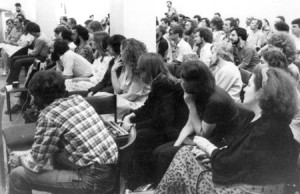 |
| Moscow. Stankolit. In the foreground – A.Tsarovtsev and Ò. Didenko, near to her Sofia Asgatovna Gubajdullina, Igor Letov (at The tape recorder) in the same line through one V.Makarov. 1983 For Igor Letovym it is seen Lepnitskiy (in tubiteika), to the right of him (in Black glasses) – Boris Grebenshchikov. In the first line in the distance Dmitry Ukhov and Alexey Batashov. 1983 |
It was the time of a gloomy resistance to the society, beginning of the 80’s. Feeling an underground a rebel and burdened with the idea of a serious mission, I searched for soul mates in the artistic environment of the underground.
Being introduced by Efim Barban, a philosopher of new music, into the elite circle of St. Petersburg musical underground, I found supporters and friends. The first person to give me his hand was Sergey Kuryokhin, of whom I had heard a lot. In my first appearance on the stage in Modern Music Club at Lensovet Cultural Center in the late 80’s I played not only solo, but in a duo with Sergey Kuryokhin. I also met new jazz musicians A. Vapirov, A. Alexandrov, V. Gayvoronsky, V. Volkov and even famous GTC, i.e. Ganelin, Tarasov and Chekasin – they had just returned from Berlin after a triumphant tour.
It was followed by soul-stirring, romantic, bright, but short friendship and playing with Kuryokhin. Sergey shortly experienced his period of free improvisational music, and we were soul mates, making plans of conquering the world. All of a sudden, I was involved in Sergey’s shocking musical actions – the first lineup of Popular Mechanics (which wasn’t called so yet) at Yaroslavl Jazz Festival in April 1981, attended by almost all musicians, relating to new jazz. Many of them, some time later, became real stars – Sergey Kuryokhin – two pianos, Sergey Belichenko – drums, Igor Butman – saxophones, Alexander Alexandrov – bassoon, Pyatras Vishnyauskas – sax, Vitas Labutis – sax, Yuri Panasenko – bass guitar, Eleonora Shlykova – piano and Vladislav Makarov – cello. Another scandalous project was introduced by V. Chekasin, accompanied by Valya Ponomaryova and Kuryokhin. This festival of uncompromising music was the first in the history of Soviet jazz. In summer of 1981 another scandal took place at the official Riga Festival, were Kuryokhin-Makarov-Alexandrov trio produced harrowing sounds in the aesthetics of late Coltrane, Cecil Taylor and hell knows what else, torturing ears of snobbish jazz audience. Kuryokhin became a persona non grata at this festival.
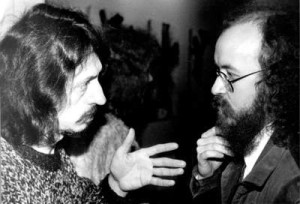 |
| V.Makarov and S.Letov. A photo of Dm. Preobrazhenskiy |
Kuryokhin started intuitively feeling for methods of special influence on the audience. In one of his letters he wrote, that he would like to combine Sex Pistols with Tchaikovsky. One year later, during one more risky performance, he offered me to play first in the spirit of Schoenberg, and then… a gypsy dance.
Once, attending Chekasin’s rehearsal in St. Pete, after Yaroslavl events, I had a minor quarrel with him, when I refused to participate in his show, feeling that it would lead me in a wrong direction. After talking with him, Alik Kan, who was the principal organizer of new jazz concerts in St. Pete and Barban’s right hand, introduced me to a strange person, drummer Alexander Kondrashkin. This meeting signified a new creative period for me. Sasha had his own philosophy and lived an ascetic life. During our first meeting he took me to his single-room apartment, crowded by a bunch of unwashed hippies, headed by an intellectual, wearing glasses. I was offered port wine and a metaphysical discussion. Being confused and excusing himself, Sasha sent away his friends, who were his home people from Ufa. Their leader was Yuri Shevchuk, a graphic designer like me. After several all-nighters we started playing together with Kondrashkin. Sasha used to come to Smolensk, where I lived, and we finally determined our musical orienting points. Sharing my ambitions and austere purist aesthetics, he was also interested in oriental philosophy and many other things, which were also close to me; he listened to free jazz, classical avant-garde and, specifically, ethnic music. In April 1982, in Leningrad, there was held a conference, devoted to “Improvisation in contemporary musical culture”, and new music concerts took place within its framework. It was a serious event on a serious level, all thanks to Barban. We played in a duo with Kondrashkin on the stage of the Tsar Theater in Hermitage. It was a good start. Leading critics and aesthetes were listening to us. Grebenshchikov, who also was there, said about our music as of a fusion between Scythian brutality and expressionistic refinement. Barban, who felt a great sympathy for me, shared his cautious comments about Kondrashkin. In spite of the fact, that Sasha’s idol was Elvin Jones, he drummed in rock style, which was noted by Efim Semyonovich. Later it finally led to rock music…
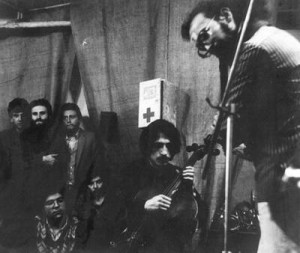 |
| Leningrad. On Peter Lavrova. On the right – S.Letov, In the middle – V.Makarov, at the left stands having crossed hands – Alexander Kan. V.Peshkov 1984 Photos |
But then we were impressed by obvious success and rushed to record our music. We did our best at an underground studio of Andrey Tropillo, were virtually all Leningrad rock musicians used to record. By the way, twenty years later this very record was included in the anthology of Russian new jazz, released by Leo Records in 2002. Sasha Kondrashkin was a very pure and fair person. He lived according to his principles, which I liked very much. It seems that I had some influence on him, and he shared my views regarding music. It seemed to me, that he fitted my style, though, as it turned out later, it wasn’t quite true.
In summer of 1993 another important event took place. Efim Barban, who was unsatisfied with my tandem with Kondrashkin, gave me address of Moscow saxophone player Sergey Letov, who he thought could be my adequate partner. Sergey Letov looked like a typical intellectual hippie. We met on a platform of Kazansky railway station and took a train to Kraskovo, where he lived and where our first historical playing together happened.
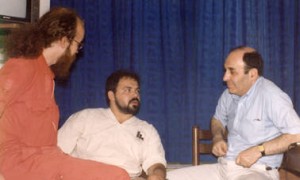 |
| Three “A” and E.S.Barban |
Sergey was a very benevolent person and we found common language at once. His dwelling was piled with books and music records. His musical style was clearly oriented to black free jazz, and, though I thought in terms of white avant-garde, it was realized that we could and should play together.
There was one more, rather strange person at Letov’s home, possessed with then radical rock music. This nervous slim youth with a haunted look was Sergey younger brother. Sergey was very strict to him, being discontent with Igor’s interest in radical rock. I tried to intercede, persuading Sergey that listening to the Doors and Led Zeppelin will not hurt his brother, but on the contrary. My own interests started with the Beatles, then shifted via Jethro Tull to a standard pattern: Deep Purple – Led Zeppelin – Emerson, Lake & Palmer – Yes – King Crimson – Mahavishnu Orchestra, then through all ECM jazz, free jazz, Rock In Opposition, Xenakis and Stockhausen to free improvisational music, which was my last stop. Nonetheless, several years later Egor Letov Jr. became a cult rocker, iconoclast and revolutionary, a historical figure of Russian underground. In a couple of days we played at a concert to the memory of John Coltrane in some cultural center of some factory. It was a big concert with many participants, including Kuryokhin, Grebenshchikov and a certain boy named Africa, as well as Moscow avant-gardists from Letov’s company (I got acquainted with them later). The venue was attended by critics Dmitry Ukhov, Tatyana Didenko and Artyom Troitsky, as well as avant-garde composers – Svetlana Golybina and Sophia Gubaidulina, if I’m not mistaken. It was my first public performance in Moscow, especially before such a venerable audience. We played with Letov several short duos, making statement of a principally new project, which was very important, and later it resulted in our long-lasting cooperation, which has been already continuing for twenty years…
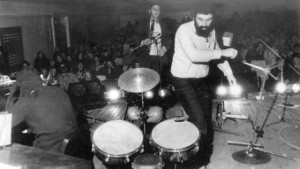 |
| ” Atonal Syndrome “. A concert in Riga. From left to right Oleg Gorbarenko, Alexander Aksenov and Michael Zhukov. 1984 |
By the way, this concert ended very badly – it was interrupted for some reason, not letting Kuryokhin play with Grebenshchikov. Those days KGB was suspected for such practice, and it happened quite often, though without me. It was strange, taking into account a specific radicalism of my music. Somehow it seemed that there were no scandals around me, but I underrated their existence and consequences. Moreover, I made a mistake, which affected my whole career.
In the beginning of the 80’s I had a contract with a London producer, Leonid “Leo” Feygin, who had just started releasing Soviet “new jazz” at his Leo Records. He had already released Ganelin’s trio, first solo work of Kuryokhin ”Way of Freedom”, and Feygin was about to record my solo effort, but asked him to wait, since I believed it was not quite ready. My hesitation was fatal, because things changed and publishers’ priorities changed too. Post-modernism gained recognition and Leonid F. felt it very promptly, staking on GTC and Kuryokhin. So, somewhat very quickly I found myself in opposition to post-modern aesthetics and social art revelry, which, I believed, instantly made famous dubious artists and actors. Meanwhile, I was busy conquering Moscow and had to consolidate forces by forming Letov-Makarov-Kondrashkin trio. It was not so easy, since we all lived in different cities.
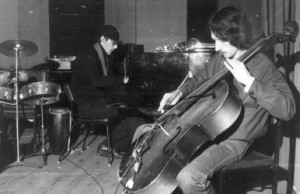 |
| Gorbarenko – Makarov duet |
It was then, when I started to distance myself from stylistics of Ganelin’s trio and didn’t see prospects of cooperation with Kuryokhin, because his onstage eccentricity and elaborated theatrical performance seemed undoubtedly unacceptable to my music. With my new trio I hoped to realize my own aesthetics. It was the very beginning, and there was no hierarchy, with the only exception that the “premier league” was occupied by GTC (Ganelin-Tarasov-Chekasin) thanks to common efforts of jazz authorities of the second echelon. I realized very distinctly, that it was necessary to create a powerful counterbalance for them. But I didn’t realize whom I was dealing with.
I think Kondrashkin was trying to conceal his increasing involvement in rock affairs for some reason. Once, in his presence, I heard a record with his participation, and he was astonished and started making excuses, saying he was just trifling. It was music of the band called Strannye Igry (Strange Games)… Nonetheless, we achieved a great breakthrough. First of all, it was a big tour, covering Riga, Smolensk, Leningrad and Moscow. When we arrived to Riga, Letov and I were introduced to the circle of local avant-gardists, flocked around the musical association “Atonal Syndrome”. Now we can definitely state that this group was a prototype of Kuryokhin’s future Popular Mechanics.
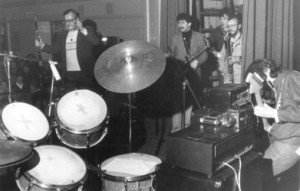 |
| Atonal syndrome – 1983. Aksenov, Letov,Makarov a guitar, etc. |
The ideologist and the leading musician here was saxophonist Alexander Aksenov, a huge guy, looking on the stage like a heavyweight boxer. He immediately found a common language with Letov regarding saxophones. Aksenov was the director of the GVF cultural center, and we easily received a stage for our invasion and, most important, a possibility to record. Everything was wonderful: we played our squally music at some festivals, organized by Aksenov, and the organizer himself tired to play our music with us, and Letov liked it, but I didn’t, because Aksenov played music close to free bop. However, in the eyes of the audience he was a super professional, unlike us, experimentalists and avant-gardists. Our trio was in the focus of attention of a group of Riga musicians. These people were a kind of an occult sect, united around Misha Nikitin – a musician and the owner of a huge collection of RIO music. He was corresponding with Chris Cutler and other distinguished rock musicians. He also was an ideologist, oriented to music of such alternative bands as Magma, Art Zoyd, Univers Zero, Henry Cow & Co. “Atonal Syndrome” was partially their project as well. In this group there was pianist Oleg Garbarenko, an absolutely inadequate person and very eccentric musician, in comparison with whom Kuryokhin looked like a candy kid. He used to play in a furious tempo, from time to time falling into a trance, continuously swallowing some pills and being a connoisseur of Cage and Stockhausen. He didn’t last long – he became demented and died soon afterwards.
And they tried to drag us into this boiling pot! Of course, we participated in some of their actions, without forgetting our music, but a real alliance wasn’t achieved, since we represented different music. Bu the way, in that company we met a guy named Nikolay Sudnik.
 |
| participants of Festival in Yaroslavl 81. From left to right Jur. Panasenko, V.Makarov, A.Aleksandrov, V.Melnikov, Efim Barban, I.Butman, E.Shlykova, S.Kurehin, S.Belichenko, P.Vishnjauskas, somebody? |
Looking like a proletarian-plumber or an authoritative jailbird, Kolya was a great and unique expert in alternative music. He started patronizing us and we had to make friends with him. And we used to stay at his place.
It turned out, that I had known Sudnik from another source. Before I started playing in Riga, I was introduced to a Riga jazz critic Antony Markhel. He lived in a mansion, which was fantastical in those days, had an aristocratic beard and a large collection of new jazz. He was Kuryokhin’s friend, and, of course, an intelligent cellist Makarov with his beautiful wife was heartily received in his house. Curiously enough, later there was a kind of a war for us between two old neighbors – Markhel and Sudnik. They had known each other for a long time and used to have long discussions about “right” music with a shot of vodka, which would constantly grow into quarrels. Markhel was a new jazz-oriented aesthete, an intellectual, and Sudnik was a principled anti-intellectual and an advocate of Rock In Opposition, being influenced by occultist Nikitin. When I come to Riga, I always have to make a choice between Markhel’s stone mansion and Sudnik’s wooden house…
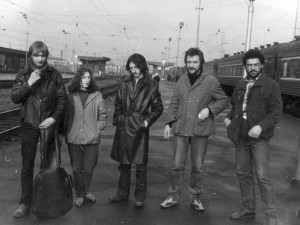 |
| Makarov and ZGA. Sudnik, E.Loseva, V.Dudkin |
In the mid 80’s, being constantly engaged in rock activities and occasionally playing with Letov, when he was in St. Pete, Kondrashkin started losing contact with me. And we played together less and less.
Now I often play in Riga with another lineup, and Sergey Letov formed his most significant project, Three O. But about this – some other time…
Leave a Reply